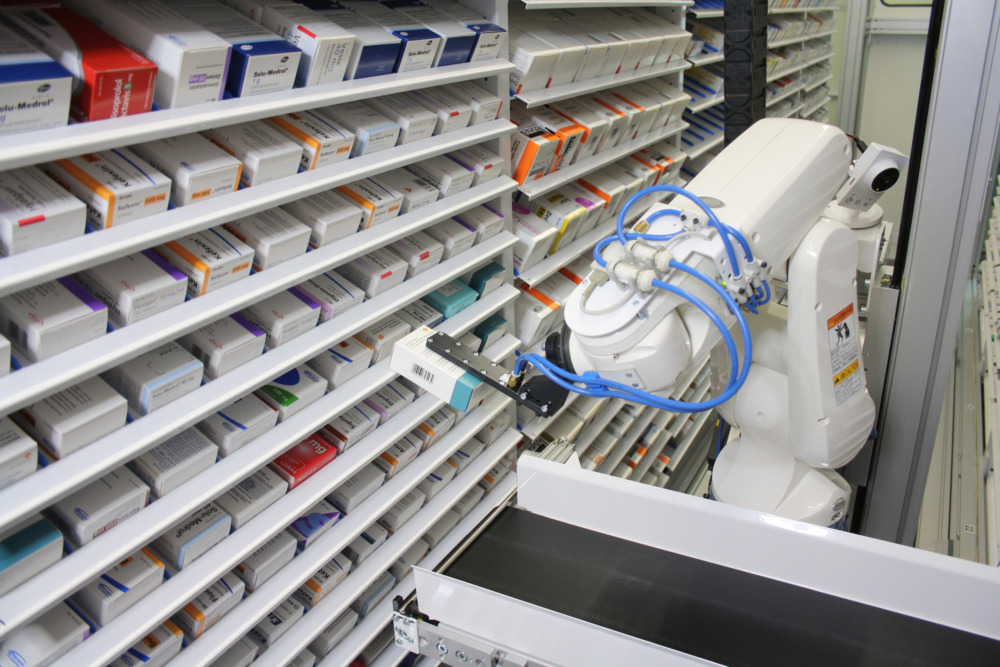
Assistants of the future help deliver medicines to patients quickly and safely
Text: Karoli Noor
Photos: NewIcon OY
Operations related to the distribution, ordering and inventory of medicines are time-consuming, and high workloads and busy periods also lead to human errors. This routine activity has not yet been optimised in Estonian hospitals. However, medicine robots have been around for some time, and excellent robots are also produced in Finland.
One of the main goals of medication management automation is closed-loop medication management, which allows the journey a medicine takes to be tracked and controlled all the way from the wholesaler’s warehouse to the patient. Various studies have shown that closed-loop medication management leads to significantly smaller drug losses due to expiration and other factors, as well as errors in the administration of drugs. It also helps to save time for hospital staff. The result is best when automated solutions are used in combination, but even a partial or gradual introduction of automation has a significant positive effect both financially and in terms of patient safety.
The components of the automation of medication handling are pharmacy robots, dosing robots for syringe solutions, smart medicine cabinets, and medicine trolleys. These components are managed by software that can be easily integrated with a hospital’s other information systems.
The medical furniture manufacturer Merianto OÜ represents the Finnish-made NewIcon robots in Estonia. “NewIcon robots were created after a pharmacist at a Finnish hospital complained to her spouse, an automation engineer, that the new pharmacy robot at her workplace was difficult to use and had many shortcomings. The resourceful spouse started working on the matter, involved colleagues and money, and designed reliable and convenient pharmacy robots. Other devices followed as a logical continuation,” said Andrus Loit, Sales Manager at Merianto.
Smart medicine cabinets
To put it simply, smart or computer-controlled medicine cabinets are similar to parcel machines – the user enters the order ID and the right cabinet door will open. Unlike a parcel machine, there are several compartments with medicines behind one door, but the requested item is marked by a lamp that lights up in the right slot. The system makes finding the required medicines easy and quick, and helps avoid grabbing the wrong medicine in a hurry.
The system is simple to use. First, the nurse identifies herself at the cabinet using an ID card or entering a PIN. Then, the nurse enters the patient’s name or the name of the medicine, after which the cabinet door or drawer with the necessary item opens. Access to certain medications can be limited to designated users, to prevent, for example, the misuse of narcotic medications. “Newlcon has worked hard to make data exchange between medicine cabinets and hospital information systems fast and problem-free,” says Loit.
The medicine cabinets communicate with each other, can monitor the level of medicines in the cabinet, and place an automatic order with the hospital pharmacy when medicines are running out. “When the medicine cabinet has run out of a medicine, the cabinet directs the user to the nearest cabinet where the medicine is available. That is, if the medicine cabinets are used in more than one department in the hospital,” explains Loit. The cabinet also monitors the shelf life of medicines.
Robots in the hospital pharmacy
Pharmacy robots are powerful assistants for hospital pharmacists. All incoming drugs are tipped from the box onto the conveyor belt, and the rest of the work – sorting, comparing with the delivery note and space-saving placement in the appropriate shelf – is left to the robot.
The robot also automatically checks the authenticity of the medicines from the pan-European database of counterfeit medicines.
When dispensing medicines, the robot assembles and packages the department’s medicines according to the order. The entire order is delivered to the department in one box, on which the robot prints the order ID. When assembling orders for departments, the robot checks the shelf life of the medicines and dispenses the products with the nearest expiry date first. This reduces the cost of writing off medicines. Still, if a medicine exceeds its shelf life in the pharmacy, the robot takes the box off the shelf and sends it for disposal.
“As the robot can complete orders very quickly, the circulation speed of medicines improves. To make sure that the required products are available, the user can always see the real-time stock levels and place new orders as soon as needed. The robot can also be instructed to place orders automatically,” explains Loit.
All robots and smart medicine cabinets are assembled using modules developed according to the customer’s needs. Personal consultation is available from Andrus Loit at andrus.loit@merianto.com.
